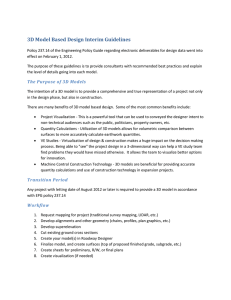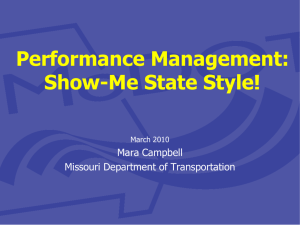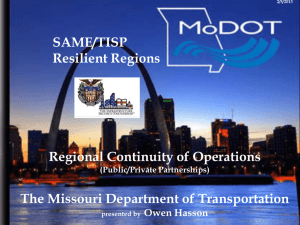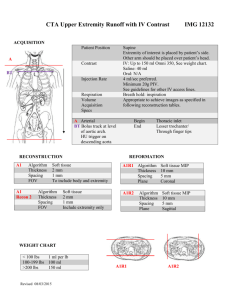Comprehensive Access Management Plan Development
advertisement
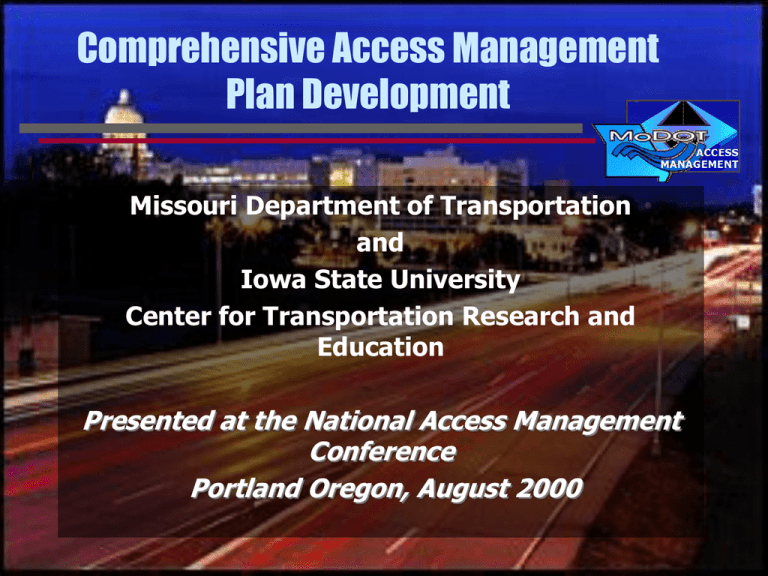
Comprehensive Access Management Plan Development Missouri Department of Transportation and Iowa State University Center for Transportation Research and Education Presented at the National Access Management Conference Portland Oregon, August 2000 Problem Statement Poor Access Management Impacts traveling public and the adjacent landowners Causes safety and operational problems Proper Access Management Balances Service to through traffic Access to adjacent properties MoDOT Highway System 32,396 Total Miles An extensive state system when compared with neighboring states 1,178 miles of Interstates 3,748 miles of principal arterials 3,707 miles of minor arterials 23,763 miles of collectors Missouri: A State of Diverse Interests Different regional perspectives Urban and rural Different levels and rates of economic development Strong property rights traditions K.C. St. Louis Branson Statutory Authority for Access Management in Missouri Missouri Constitution, Article IV, Section 29, “Highways and Transportation”: “The highways and transportation commission shall have authority over all state transportation programs and facilities as provided by law, including, but not limited to, bridges, highways, aviation, railroads, mass transportation, ports, and waterborne commerce, and shall have authority to limit access to, from and across state highways where the public interest and safety may require.” Access Management Project Initiation Generated interest in the concept of access management Identified and involved stakeholders Established project objectives Established working committees Took a comprehensive approach Established Project Objectives Develop a comprehensive approach to access management Develop all necessary classifications, standards, guidelines, and administrative processes Identify access management problem areas Provide training, both inside and outside MoDOT Generated Interest in Access Management, Both Internally and Externally Identified Stakeholders External Stakeholders Traveling public Real estate developers Economic development entities Local governments FHWA Internal MoDOT Stakeholders Design Planning Traffic Right of Way Legal Oversight Committee Roles Set program goals Direct technical committee Provide diverse viewpoints Oversee outreach initiatives Oversight Committee Real estate developers Economic development official City planner Regional planner Consulting engineer Elected city official FHWA MoDOT senior managers Technical Committee Roles Develop classification system Develop standards and guidelines Assist in problem identification task Technical Committee City planner City traffic engineer MoDOT district personnel Planner Traffic engineer Permit personnel Project managers Right of way manager MoDOT GHQ personnel Traffic Design FHWA - Missouri Division Took A Comprehensive Approach Improve safety and operations reduced delay increased capacity Department-wide policy to facilitate consistency within MoDOT Guidance for local municipalities for development of complementary plans Provide predictable standards Project Components Access management goals Access management classification system Access problem location identification using GIS and crash data Access management standards and guidelines Administrative processes Outreach and education program Access Management Program Goals Improve roadway safety Improve traffic operations Protect taxpayers’ investment Create better conditions for non-automobile modes Access Classification Systems Standards must properly fit the present and future functional role of the highway. Useful tool to explain the function of the roadway and the related level of access management A necessary first step in the department-wide coordination of the plan Proposed Access Classification Urban Rural Interstate/Freeway U1 R1 Principal Arterial (A) U2 R2 Principal Arterial (B) U3 R3 Minor Arterial U4 R4 Collector U5 R5 U indicates Urban: The highway is within current urbanized or census urban areas or an area forecast as urban within 20 years. Note: Future urban highways should be planned as such, in terms of access management. R indicates Rural: The highway is not within a current and is not in a 20 year forecast urban area. Problem Identification Task A number of corridors in Missouri currently exhibit symptoms of poor access management. GIS analysis using crash records was used to identify and visualize these problem areas. Problem corridors are found in all ten of MoDOT’s Districts and in rural as well as urban and suburban areas. District 6 Access-Related Crashes Southwest St. Louis Suburbs District 5 Access-Related Crashes Jefferson City Access-Related Crashes Missouri Boulevard, Jefferson City: Typical Arterial With Poor Access Management District 4 Dot Location Crash Map District 4 Dot Location Crash Map # # ## # # ### ### 20 # # # # # # # # # ## # ## # # # # # ## ###### # # # # # # # # # # ## #### # # # # #### # ## # # # # # # #### ## ## ###### ### # # # # # ##### ## ## ###### # ## # ### ## # # # # ## # # # # # # # #### # # ## ## # ## ##### ## ## ######## ####### ## # ### ###### # # ####### # # # # # ### ######### # # # # # # # # # ## ##### #### ## ## # # #### # ## # # ##### ### ### ## ## ########### # # # # ## # # # # # # #### # # # ### # #### # # ## ## ## # # ## # # # # # # # # # # # ### ### # # ### # #### ## ### ## # ## ## # ## ## ## ## # ######### ###### ## ##### ## # ##### ## ####### ### # # # # # ### ##### # # # ################ # ## # ## # ## # # # #### ## # # ######### ### ## ## # ## # ###### ########### # ## ## ## ## # ## ## # ## # # # # # # # ## ### # # # ### # # ### ## # ## # ## # # # # ### # # # # ## # ### # # # # # # # # # # # ## # # # # # # # # # # # # ## #### ############### # # ## ## ## ##### ### ## ############ ### ## ## # #### ## # # # ## ### # # ### ################ ###### # # ## # # # # ################## # ### ######### ###### # # ## ### ## ################# ## # # # # # ################ ## ### ## # # ####### # ## # ##### # # # # ###### # ## ##### # # # ### ## # # ### # # # # # # # # # # # # # # # # # # ## ############ # # # # # # ## # # # # # # ### ## ###### # ##### # # ## ## ########## ## ## ## # ## # ### # ### # # ######### ### #### ## # #### # # # # # # # ## # # # # # ### # # # ### # # # ## # # # # # # # ## # ## # # # # ## # ## ########### ## ####### # ## # # # # # # # # # # # ## # # # # # # # # # ## ###### # # ## ## # #### ###### # # # # #### # # # # # # ## # # # # ### ############ ## # ######### ##### ######## # # # # # # # # ## ###### # # ## ###### #### ## ##### # ### # # # # ## # # # ## # # ## # # ### # # # ## # ####### ############# ## # # ###### ################# # # # # ###### ## ### # # # # # # # # # # # # # # # # # # # # # # ## # # # ## ## # #### ### # # ### # ## # ####### #### ## # # ## #### ## ###### # # # # # # # # # # # ## ## ######### ### # ## ## # ### # # ## ## # # ### ## # ## # # # # ## ## # # # ##### # # # # ##### # # # # # # ## ### # ## ## # # # ## # # ## # # ## # # # # # # # # ## ### # # # # # # # # # ### ### ############ # ############ # ## # ### # ## ## # # # ## # ##### ### # # # # # # # # ### # ## # # # ## # ## ## # # # # # # # # # # # # # ## # # # # ## # # # #### ## # # # ## ## # # ## # ## # # ## # # ## # ## ### # ## # # ## # # ###### ########### # ###### # # # # # #### ## ##### ## #### ## # ####### # # # # # # # # # # # # ## # # # # # # # # # # # # # ## # ##### # ## # # # ## 0 # # # # # # # ### # ##### ## # # # # # 20 # Dist4 Relevant Crashes Dist4 Arterials Dist4 Collectors N W E 40 Miles S District 4 Stacked Crashes Map District 4 Stacked Crashes Map # # ## # # ## 20 0 # # # # # # ### # # # # ###### # ##### # # # # # ### # # # # # #### # # # ##### # # # # # # #### # #### # ##### ########### ### # # # # # ###### ### ## ###### # # # # ### ### # # # ## # ## ## # # # # # ## ##### ### ############ # ## # ###### ######## # # ######## ## # # ########## ### # ### # # # # # #### ## ### ## # ####### # ## # ################ ### # # #### # ### # # ## ## # # ## # ## ##### #### # # # # ## # # ## # # ### # # # # # ### # # # # # ##### ##### ### ## # #### # # # # # # ##### ## ## ####### ## ##### ########## ## # ##### # ### # # # # # ## #### # # ## # ####### ######### ## ############# # ### ### # # ### ## ## ## ###### ########### # ## # ##### # ## # ## # # # # # ## # # #### # ##### # ## ## # # # ## #### # # ##### # # # ## # # ## ## # # # ## ## ## # # # # # ## # # # # ### # ############ # # ## ## ## ## # ##### ## ## ## ## ### ###### ## ## ## ### # ### # # ############### ## ### # # # # ## # # ################ # ### ######## # # ##### ## ### ## ############## ## # # # # # ############### ## ## #### ## ### # # # # ######## ## ### # # ###### # # # ## # ## # #### ##################### ## # # # # # # # #### # # ## # # # # # # # # ####### # ######## # # ## # ## ########## ## ## ## ## # ### # # # # ## # #### ## # # # ###### ### # # # # # # # # # # # # # ## ## # # ### # # # # # # ## # ## # # # # # ## ## ############### ####### # # # # # # # # # # # # ### # # # ## # # # # ## # # # # # # # # ## ## ##### # ###### # # ####### ## # # # # ##### ############ ## # ################### # # # # # ###### ### # # ######## # ## ##### ##### ##### ## # # # ## # # ## # # # # # # ## # # # ########### # # ### # # ## ########## ## # # ## # ###################### ####### # # # # # # # # # # # # # # ## # # # # # # # # # # # #### # ######## ## # ## # # # ##### ## #### # # # # ##### # # # ## ### ##### # # # ## ## ######## ##### ## # ### # ## # # ### # # # # # # # # # # ### # ######### # ## # ### # ## ## # # # # #### # # # ## # # # # # # ## # # ## # # # # # # ### # # # ### ## # # #### # # # #### ## ###### #### # ## # ## # ### # ###### ## ## # # # ## # # # #### ## # # # # # ### # ## # # # # ## ## ## # # # # # # # # # # # # ## # # # # ### ## # # # ## # # # ## # # # # # ## ## # # # # # ## # ### ### # ## ## # ### # # ###### ############# # # # # #### #### ###### ###### # # # # # ## # # # # # # # ## # # # # # # # # # # # # ### # # # # # # # # # ## ## # # # # # # # # # # # # # # 20 # # ## # # # Dist4 Relevant Crashes Dist 4 Interstates/Freeways Dist4 Arterials Dist4 Collectors Count5.shp N W E 40 Miles S Features To Be Managed: Interchanges and Intersections Interchange spacing Clearance of functional areas for interchanges Freeway/expressway transition Public road intersection spacing Traffic signal spacing Features To Be Managed: Driveways Driveway spacing and density Corner clearance and clearance of functional areas of public road intersections Sight distance minimums Driveway geometric design Angle of intersection Approach radii Width Throat length Grade Surfacing and curbs Features To Be Managed: Other Median openings Guidelines for use of TWLTLs, “Three Lanes”, and raised medians Warrants for auxiliary turn lanes Frontage and backage road spacing from mainline routes Recommended practices for local land use planning agencies Consideration of non-auto modes in managing access Example Standards Interchange spacing Clearance of interchange functional area Traffic signal spacing Driveway spacing Median openings TWLTL versus raised median Interchange Spacing Roadway Classification In Current and Projected Urban Areas In Rural Areas Interstate/Freeway 10560 feet (2 miles) 26400 feet (5 miles) Principal Arterial (A)* 10560 feet (2 miles) 26400 feet (5 miles) Principal Arterial (B)* 10560 feet (2 miles) 26400 feet (5 miles) Minor Arterial Generally not applicable Generally not applicable Collector Generally not applicable Generally not applicable A Clearance of Functional Areas of Interchanges Type of Area Minimum Distance from OffRamp to First Right-In, Right Out Driveway (X) Minimum Distance to First Major Public Road Intersection, Full Median Opening, Or Left-Turn Opportunity (Y)* Minimum Distance from Last Right-In, Right Out Driveway to On-Ramp (Z) Urban 750 feet 1320 feet 750 feet Rural 1320 feet 2640 feet 1320 feet Traffic Signal Spacing Roadway Classification In Current and Projected Urban Areas In Rural Areas Interstate/Freeway Traffic signals not allowed Traffic signals not allowed Principal Arterial (A) 2640 feet (1/2 mile) * Principal Arterial (B) 2640 feet (1/2 mile) * Minor Arterial 2640 feet (1/2 mile) * Collector 1320 feet (1/4 mile) * * Rural traffic signals are generally isolated signals rather than signals placed in a progression along a route. Signals should be placed at least one mile apart due to high operating speeds in rural areas. Driveway Spacing Roadway Classification In Current and Projected Urban Areas In Rural Areas Interstate/Freeway No driveways are allowed No driveways are allowed Principal Arterial (A) 660 feet (1/8 mile) 1320 feet (1/4 mile)* Principal Arterial (B) 440 feet (1/12 mile) 660 feet (1/8 mile)* Minor Arterial 330 feet ( 1/16 mile) 440 feet (1/12 mile)* Collectors 220 feet (1/24 mile) 330 feet (1/16 mile)* * The urban standard may be applied in developed areas that are not urban, for example cities with populations under 5000. On collectors in cities with population under 5000, the recommended minimum standard is 220 feet (same as the urban standard). Median Openings Roadway Classification In Current and Projected Urban Areas In Rural Areas Interstate/Freeway No median openings allowed No median openings allowed Principal Arterial (A) 2640 (full) 2640 feet (full) when posted speed is over 45 MPH 1320 feet (directional) 1320 feet (full) when posted speed is under 45 MPH Principal Arterial (B) 1320 feet (full) 660 feet (directional) 2640 feet (full) when posted speed is over 45 MPH 1320 feet (full) when posted speed is under 45 MPH Minor Arterial 1320 feet (full) 1320 feet (full) at all speeds 660 feet (directional) Collector Medians generally not used Medians generally not used Two-Way Left-Turn Versus Median Roadway Classification In Current and Projected Urban Areas In Rural Areas Interstate/Freeway Not applicable Not applicable Principal Arterial (A) May be used when appropriate if AADT in design year is less than 28,000; otherwise use a raised median Do not use Principal Arterial (B) May be used when appropriate if AADT in design year is less than 28,000; otherwise use a raised median Do not use Minor Arterial May be used when appropriate if AADT in design year is less than 28,000; otherwise use a raised median Do not use Collector May be used when appropriate if AADT in design year is less than 28,000; otherwise use a raised median Do not use Desirable Administrative Process Features Partnerships with local land use planning officials Pre-application/ Design review meeting with developers On-site review by District staff Statewide standards that allow most decisions to be decentralized A clear and simple initial permit application process Decision criteria that are easily understood by permit applicant Short, but adequate MoDOT review time A clear appeals process Permit expiration times Suggested Administrative Goals Make safe and operationally beneficial access decisions Protect the public investment in roadways Provide a timely and predictable decision making process for landowners and developers Encourage uniformity statewide, especially on highlevel use Make decisions based on clear and logical access standards Allow flexibility and engineering judgement where warranted (this can lead to stricter controls when they are needed) Keep the number of variances at a reasonable level Provide for an efficient appeals process Set solid precedents for future access decisions Approval Process Time Lines From Example States Colorado: 45 days (initial 20 day review for completeness) Florida: 90 days (initial 30 day review for completeness) Georgia: 20 days total Kansas: Requires site plan, then a 20 day review Ohio: No time line stated Oregon: 120 days total Pennsylvania: 30 days total South Carolina: 90 days total Virginia: 45 days total Wisconsin: No time line stated Suggested Permit Review Timetable Suggested driveway permit review timetable: Required pre-application meeting (the clock does not start running until this occurs) The pre-application meeting should help weed out and improve applications Initial review for completeness--20 days Maximum time to approve or disapprove--45 days assuming a completed application A notice to proceed is issued to approved applications Pre-Application Meeting The pre-application meeting should include: The applicant and his/her representatives MODOT District Staff Appropriate local government agencies (e.g. land use planners) The goal of the meeting is to improve the application and reduce the need for variances Variances Guidelines and standards can never address every issue or situation Variances often have the long-term effect of lowering standards and guidelines It is important to track them and see if the standards need to be revised--variances that are routinely granted are really new standards Safety needs to be the number one concern in granting or not granting variances Hierarchy of Features Usually Involved In Variances Hierarchy of Features Level of Importance Sight distance Most critical of listed features (potentially large safety impact) Interchange spacing +++++ Traffic signal spacing ++++ Driveway spacing +++ Corner clearance + Number of driveways per property/lot frontage Least critical of listed features Source: New Jersey DOT Valid Bases for Variances Strict application of standards would be unreasonable (a unique local situation exists) Existing conditions are substandard and applicant cannot be reasonably asked to fix it Environmental, social, or economic constraints exist Conflicting requirements of MODOT and other jurisdictions (Federal, state, local) The situation is very near a threshold or boundary for a standard Source: Adapted from New Jersey DOT discussion of variances Access Decisions Should Be As safe and operationally-beneficial as possible To protect the public investment Timely and predictable Uniform statewide, especially on high-level routes Based on clear and logical standards Good precedents for future access decisions Decision Processes Should Not be politically driven Keep number of variances at a reasonable level Provide a timely and efficient appeals process Allow flexibility and engineering judgement when warranted Educational and Outreach Process Features Provide training on classification, standards, problem locations, and administrative process for MoDOT staff Increase overall awareness of access management within “highway community” beyond MoDOT Past training and presentations for highway engineers and traffic engineers Educational materials now being developed for land use planners, business community, and others Educational and Outreach Process Features Provide materials to educate local officials and the general public on the benefits of access management Safety Traffic operations and congestion More efficient use of taxpayers’ dollars Impact of access management on adjacent businesses and on economic development Success Of The Plan Will Be Dependent On Coordination Within MoDOT Between Support Center and the districts Between Planning, Design, Right of Way and Traffic Between management and those implementing the plan Between MoDOT and local governmental entities responsible for Regulating land use Managing non-MoDOT roads Coordination With Local Governmental Entities Training for local officials will be provided along with training for MoDOT personnel Suggested guidelines will be established for local entities (to be used at their discretion) Guidelines will be developed for MoDOT to encourage close working relationships between MoDOT and local planners and engineering staff
